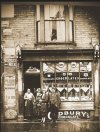st anns. school
Duddeston Mill on the River Rea at Duddeston Mill Road was the Holte family's manorial cornmill. In 1540 the Crown Steward who was administering Birmingham manor complained that Birmingham people were using Duddeston Mill instead of Birmingham's own manorial Heath Mill. However, Edward Holte was able to prove that Birmingham's mills had often been inadequate and that his grinding Birmingham corn had been agreed with the previous lord of the manor, Edward de Birmingham. Trade increased and the mill was rebuilt c1570 with three pairs of stones. By 1744, in common with many local mills, it was being used more profitably for metal rolling, blade making and gun-barrel boring by James Farmer.
Gun-maker Samuel Galton, who lived nearby at Duddeston House, rebuilt the mill which continued to make gun barrels until 1888. The mill's weir caused problems in Deritend by holding up the raw sewage discharged from Birmingham a mile upstream. Disastrous floods in 1852 spread raw sewage throughout the lower town and prompted the weir's removal. The unreliability of a constant water supply led to the mill being converted to a steam-powered sawmill. After closure the site was bought by the Midland Railway standing as it did alongside the Birmingham-Derby line.

Duddeston House, Saltley gas works in the background 1954 photographed by Phyllis Nicklin - see Acknowledgements, Keith Berry. At this time it was St Anne's School
On the east side of Devon Street was the Galton family home. Known as
Duddeston House, or later confusingly Duddeston Hall, it had been built in a neo-classical style in 1758. There were extensive grounds along the river with a lake covering 2 hectares which was stocked with exotic waterfowl. Samuel Galton Junior was a man of many interests. It was he who discovered that the seven colours of the spectrum are made up only of red, yellow and blue.
After the Galtons left in 1838 the house was used as a lunatic asylum until 1865. and with increasing urbanisation, from 1868 for the overflow of infants of St Matthew's School in Cato Street. As the population continued to increase, the building was altered the following year to accommodate a teacher's house and some 750 pupils, and was renamed St Anne's National School. However, Her Majesty's Inspectors reported poor buildings and poor education iin 1894. The Board of Education were still demanding improvements in 1912. As part of the wide-scale redevelopment of the area the school was closed and the building demolished in 1971 with the children transferring to the new St Matthews School on Duddeston Manor Road.

 Source: Birmingham Mail Archives
Source: Birmingham Mail Archives
 Source: Birmingham Mail Archives
Source: Birmingham Mail Archives









